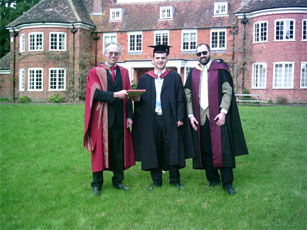Electromagnetic and Thermal Modeling of the Human Eye
 Hrvoje Dodig graduated from the University of Split, Croatia and has successfully passed his MPhil Viva at WIT with a thesis on “Electromagnetic and Thermal Modeling of the Human Eye”. The external examiner was Prof Peter Excell, Professor of Applied Electromagnetics from the University of Bradford and the internal was Dr Andres Peratta.
Hrvoje Dodig graduated from the University of Split, Croatia and has successfully passed his MPhil Viva at WIT with a thesis on “Electromagnetic and Thermal Modeling of the Human Eye”. The external examiner was Prof Peter Excell, Professor of Applied Electromagnetics from the University of Bradford and the internal was Dr Andres Peratta.
The objective of the research was to develop some useful accurate 2D numerical modelling of the human eye exposed to high frequency electromagnetic radiation.
Hrvoje’s research investigates the influence of high frequency time harmonic electromagnetic fields on the human eye. The task carried out in this thesis was two-fold; as a first step the total electric field and resulting SAR (specific absorption rate) inside an eye and surrounding tissues was calculated. The data from the field distribution and the SAR calculation was then provided as an input to the bio-heat transfer equation to obtain the temperature field distribution inside an eye.
An eye was not considered as the system isolated from the rest of the head; it was therefore modelled together with part of the head which can considerably influence the electric field distribution inside an eye at the given frequency. The consequence of this was the greater number of tissues involved.
Dispersion of electric parameters of the tissues at various frequencies is well known and is usually approximated using the 4-Cole-Cole extrapolation. Moreover the conductivity and permittivity parameters of the tissues were obtained from electric parameters measurement performed either in vivo or from autopsies. This data was collected systematically by other researchers and used in this thesis for the purpose of modeling the human tissues.
Next, a plane wave incident on the eye and on the part of the head containing it was considered as an electromagnetic scattering problem. For this reason, the hybrid BEM/FEM formulation was used in order to calculate correctly the scattering of electromagnetic fields. Another reason why hybrid method was used is in inhomogenity of tissues involved. The inhomogenity issue was resolved via direct treatment of Maxwell’s equations. Furthermore, this hybrid formulation was altered in a way that discontinuous boundary elements were used with hybrid formulation thus providing the better accuracy of the method and resolving the problem of non-uniqueness of the fluxes at the corners. The justification of the method and the comparison with other methods was provided as well.
Finally, the specific absorption rate (SAR) was calculated from the distribution of the electric field inside an eye for the frequency range from 0.7 GHz to 4.4 GHz. This data was then fed into the bio-heat transfer equation for steady state to obtain the temperature field distribution at the given frequency range.
The results from this research may have various applications ranging from medical to safety applications. The data and the methodology used may eventually have practical applications in medicine such as hyperthermia treatment of rare eye cancer forms or it could be used to re-asses the exposure limits to electromagnetic fields for the human tissues.
Hrvoje presented an excellent MPhil thesis as a result of his research. He was congratulated by the external examiner Prof Peter Excell and by the internal examiner Dr Andres Peratta. Hrvoje is now returning to Split, Croatia where he will continue to work on this problem through PhD research.
Grateful Acknowledgement is given to the British Council for their support.


 Wessex Institute
Wessex Institute